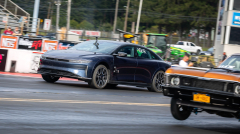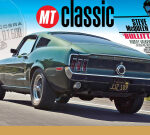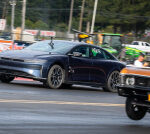By my estimate, Ned Dunphy’s 2013 Viper could probably run a 6-second quarter mile at around 200 mph while pulling a trailer. Good luck finding a Y-rated trailer tire or a venue that would allow such a stunt, but I’m confident in that assessment based on two facts: 1) Sans trailer, Dunphy’s tube-frame race car runs the quarter in as little as 6.114 seconds at 247.57 mph. 2) I watched the car make four other passes within 0.104 second and 1.85 mph of that best run at four different dragstrips over the course of a week, between which it towed a trailer loaded with tools and spare parts 660 miles.
I encountered Dunphy’s Viper and 411 other cars like it (I’m using a broad definition of “like”) at HOT ROD Drag Week, an annual event that more or less started as a way to get people to shut up about what is and isn’t a street car. It was inaugurated 21 years ago by David Freiburger, who was then the editor-in-chief of Hot Rod. Freiburger was tired of getting letters and emails from readers complaining that owners of the show-quality and/or vicious cars in his magazine couldn’t possibly drive those cars on the street. He figured nobody could point and whinge “not a street car” if it had driven some 1,000 miles in a single week, stopping at a different dragstrip every day to confuse the issue by laying down some decidedly race-car-like elapsed times. Forty drivers showed up for that first Drag Week in 2005, driving 1,500 miles between tracks. Carl Scott won in his 1967 Chevrolet Nova, averaging 8.58 seconds in the quarter mile at 157.13 mph.
In the immortal words of Ron Burgundy, “Boy, that escalated quickly.” At the end of Drag Week 2025, more than 20 cars averaged lower ETs than Scott’s Nova, with a similar number making at least one pass quicker than his average. Hot Rod has been limiting Drag Week to 400 cars for the last 10 years or so. For 2025, those spots sold out in mere minutes, and when the track opened for tech inspections the day before racing began, 89 racers who had been placed on a waitlist were lined up hoping for registered entrants to drop out. One of those on the waitlist had shipped his 8-second ’73 Corvette—and three generations of his family—from New Zealand. When he was admitted, the whole family hugged the Hot Rod staff. Sellout crowds packed some dragstrips, and thousands more tuned in to watch the livestream on YouTube with Freiburger and NHRA commentator Brian Lohnes calling each day’s action.
Anticipating the “but buts” of the couch critics, Freiburger decreed from the start that no support vehicles would be allowed at Drag Week. You drive your car from strip to strip, and anything you think you might need—slicks, jack, toolbox, spare rotating assembly, center section, transmission, whatever—had better fit in the car with you. Or you can cram it into a trailer and tow that with your race car. More than 250 cars in this year’s contest joined Dunphy’s Viper in dragging a trailer between venues.
I needed no trailer in the Lucid Air Sapphire, which we entered in Drag Week not, as some racers alleged, to troll the competition, but out of genuine curiosity. With its 1,234 horsepower and space for four passengers to ride in sumptuous comfort, the Sapphire might just be the ultimate factory-stock weapon for Drag Week’s race/road rally format. And while I can think of few demographics more likely to be hostile to EVs than hardcore drag racers, few crowds are better positioned to appreciate the Lucid’s record-breaking acceleration than people who have themselves built cars to pursue ever-lower ETs. Would hot rodding’s most fervent disciples accept the Air Sapphire? Or at least respect it?
Outrunning the Rulebook
We couldn’t have done this prior to 2022. When the Dodge Demon made its debut in 2017, Dodge proudly proclaimed it banned by the NHRA. The rules in place at the time dictated that any car running the quarter mile quicker than 9.999 seconds and faster than 135 mph have, among various other safety features, a certified roll cage. In recognition of the rapidly advancing performance capabilities of modern performance cars—and their equally remarkable safety—the NHRA changed its rules in 2022 to allow stock vehicles from model year 2014 and newer to run as quick as 9.000 seconds at up to 150 mph without aftermarket safety equipment. Any quicker, and you need a cage. Any faster, and you need a parachute to help the car stop.
The Sapphire, then, is the perfect vehicle for Drag Week, its 9.03-second quarter mile at 154.8 mph flirting with both limits. If I can get a better launch on the dragstrip than on MotorTrend’s usual testing surface, which mimics the traction available on a normal public road, I might get tossed out for not having a roll cage. I’ll also have to watch the speedometer and possibly lift at the top end to avoid being DQ’d for leaving the parachute at home—which, come to think of it, will make it that much harder to be punished for our bone-stock crash structure. This should be an interesting week.
Drag Week moves around the U.S. every year, starting and ending at one track and visiting three others in between. For the event’s 2025 running, we start at Maryland International Raceway in Budds Creek, Maryland. Then we progress through Numidia Dragway in Numidia, Pennsylvania, Maple Grove Raceway in Reading, PA, and Cecil County Dragway in Rising Sun, MD, before returning to Maryland International. The 660-mile road trip is short by Drag Week standards. They typically average around 1,000 miles and have stretched as far as 1,500, varying according to the location of suitable dragstrips within each event’s host region.
Lined up in the staging lanes at MIR on the first day, few other racers show any interest in our bone-stock new car. I get a lot of nasty looks and overhear several derisive comments, but nobody will make eye contact lest I misinterpret it as an invitation to interact. Of those I do manage to corner and force into conversation, none have heard of Lucid—and interest evaporates when they learn it’s electric. One fellow racer asks what I expect to run. When I tell him I’m looking for low nines, he responds with a dismissive, “Sure you are.”
He’s right. The Sapphire can run low nines, but despite the NHRA rules, I’m looking for a 10.000. Racers at Drag Week compete in 10 different classes determined by the construction of the vehicle, its engine displacement, and aspiration. Since the Lucid has three motors but zero engines, it doesn’t fit into any of the existing classes and gets crammed into Street Machine Eliminator, which is limited to elapsed times of 10.000 seconds and slower. Finishing order at Drag Week is determined by average elapsed time (ET) over the week. You can only hand in a single time slip each day; run quicker than a 10.000 in SME, and you officially log a 20-second pass. Just one of those will ruin our average and our chances at a favorable finish.
During a test session prior to the official start, I count “one thousand one” out loud after the Christmas tree goes green before flooring it and run a 10.035 at 145.75 mph. Given the skilled bracket racers populating our class, I could average a 10.035 for the whole week and not even finish in the top 20. Once competition gets underway, I rush the count and run a 9.895. Racers are allowed multiple runs each day, but everybody has to get at least one first. With more than 400 cars starting Drag Week, I only get one more run the first day. Drawing out the “one thousand one,” I still run a 9.980. Crap. Should have eaten a second burger from the concession stand at lunch.
Whatever. I didn’t bring a Lucid Air Sapphire to Drag Week to prove I’m not a good bracket racer. I came to see what this 1,234-horsepower EV can do. If I log a 20-second time each day and come in dead last but win over a few competitors in the process, that’s a win.
The Rally Between Races
While the rest of the Drag Week entrants worry about overheating and other woes associated with asking high-strung racing engines to behave on the transit stages, my only concern in the Lucid is range. With an EPA-rated range of 427 miles on a full charge, I don’t anticipate that being much of a problem, either. Every spectator and fellow racer I talk to is amazed by that figure, and several jaws drop over the course of the week when I tell people there’s another Air, the Grand Touring, with a range of 512 miles. I’m feeling a little sheepish about the 6 or 7 miles of juice each pass down the strip consumes, until a guy in a nine-second Nova tells us he averages 10 mpg on the street but burns a gallon of 110-octane (roughly $20 per) with each pass.
After turning in their time slip at the close of racing ea





